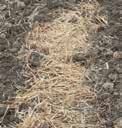chAPter 15 Preventing and lessening CoMPaCtion
using controlled traffic lanes, and using permanent beds
SOURcES
(that are never driven on) are ways to avoid compaction.
Gugino, B.K., Idowu, O.J., Schindelbeck, R.R., van Es, H.M., Wolfe,
D.W., Thies, J.E., et al. 2007. Cornell Soil Health Assessment
Also, reduced tillage and larger organic matter additions
Training Manual (Version 1.2). Geneva, NY: Cornell University.
make the surface less susceptible to the breakdown of
Kok, H., R.K. Taylor, R.E. Lamond, and S. Kessen. 1996. Soil
aggregates and to crust formation—as does maintain-
Compaction: Problems and Solutions. Cooperative Extension
Service Publication AF 115. Manhattan: Kansas State University.
ing a surface mulch and routine use of cover crops.
Moebius, B.N., H.M. van Es, J.O. Idowu, R.R. Schindelbeck, D.J.
Reducing compaction once it occurs involves using cover
Clune, D.W. Wolfe, G.S. Abawi, J.E. Thies, B.K. Gugino, and R.
crops that are able to break into subsurface compact
Lucey. 2008. Long-term removal of maize residue for bioenergy:
Will it affect soil quality? Soil Science Society of America Jour-
layers and using equipment such as subsoilers and zone
nal 72: 960–969.
builders to break up compact subsoil.
Ontario Ministry of Agriculture, Food, and Rural Affairs. 1997.
Soil Management. Best Management Practices Series. Available
from the Ontario Federation of Agriculture, Toronto, Ontario,
Canada.
171
Building SoilS for Better CropS: SuStainaBle Soil ManageMent





